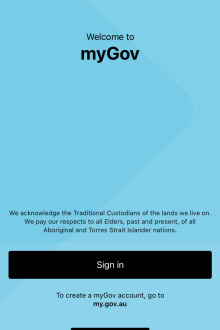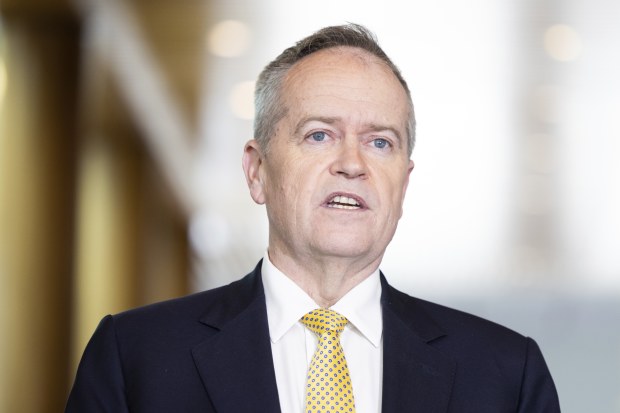New myGov app to be platform for public and private services
The new myGov mobile app is being pushed as the single place to manage both government and private sector services, enabling integration through a single secure digital identity under a plan being developed by Government Services Minister Bill Shorten.
Mr Shorten launched the myGov mobile app on Monday in Sydney, revealing a number of features including facial recognition to enable easy log in, a wallet to keep important government documents in one place, and notifications for services such as tax refunds.

The new myGov is dressed in sky-blue and creates a single interface to access 15 Australian government services.
The app is dressed in the same sky-blue colour pallette, design elements and font types as Services Australia and the myGov website, creating a similar interface and sign-posting for users.
Mr Shorten has recently returned from a digital government study and is keen for myGov to offer the type of highly integrated public and private sectors services that citizens in the nordic European region enjoy.
This includes tight synchronisation with banking, airline, health, transport and other corporate services which need an authenticated identity.
The myGov website is Australia’s largest authenticated digital platform, with 25 million linked accounts and more than 1 million sign-ins each day.
“You can use the features of your phone to access 15 Australian government services,” Mr Shorten told The Australian Financial Review.
“So that’s things including Centrelink, Child Support, Veterans Affairs, Medicare.
“Once you’re on your phone and use the security features of the phone face ID or a PIN number to log on, you don’t need to sign on again. That saves time.”
The new app also has a digital wallet to store virtual cards such as immunisation certificates. Medicare cards and passports will be able to be added to the app in March.
Mr Shorten said this would help people more easily establish their 100 points of identity
The cards that it will currently be able to store are the pensioners’ concession card, the Commonwealth seniors’ healthcare cards, but also your Medicare card by March,” he said.

Government Services Minister Bill Shorten recently returned from a digital government study in Europe. Alex Ellinghausen
“That’s all valuable ID which, if someone wants your ID, you can just use a QR code and the person taking the ID gets the verified identity without you having to give this organisation all your personal details.
“It also means it is harder to hack. I think in the light of the [Optus and Medibank] hacks that’s become an interesting feature.
“This means that organisations don’t need to keep your material, it’s actually a relief to them.”
The app provides access to two Victorian government services and Mr Shorten signalled he wanted to work with the states to also host digital driver’s licences on the app, creating a single app for federal and state services.
“We will start with the largest set of users of myGov, the largest number of users, 25 million users [linked accounts],” he said.
“I would like to get driver’s licences onto it. And then maybe what we have to do is let some of the state apps use the Medicare [card] and just see what happens.”
Three out of four NSW car licence holders have downloaded the app and Mr Shorten said he had spoken with Digital Minister Victor Dominello about bringing Medicare into the state Services NSW app. This would improve integration with the state hospital systems.
The launch of the app comes after Mr Shorten asked former Telstra and IBM chief David Thodey to lead a user audit of the myGov service portal. This is expected to push for tighter integration with the Tax Office’s myGov ID system and for all federal services to be accessible through the new app and in one consistent digital environment.
‘We need to catch up’
Mr Shorten recently visited Estonia and Denmark, two of the leading digital governments.
Estonia is a country of 1 million people. They’ve answered some of the questions we’ve struggled with. They have a card with a chip, and it contains hundreds of government services and private sector businesses. It’s amazing,” he said.
“And you don’t have to tell your story again and again. I guess a new country doesn’t have a legacy of colonial ministries. But it is still remarkable.
“We need to just catch up.”
Mr Shorten said some Australian technology such as prefilling forms and the single touch payroll system were solid.
“But considering what other countries are doing, they’re doing things in their interaction with the private sector and interoperability which are remarkable, which we’ve just never even thought of,” he said.
“Once people think about it myGov will give you authenticated identity which they can use.”
Mr Shorten said he had also met the European Commissioner for Justice Didier Reynders, whose office oversees the European privacy regime known by the acronym GDPR.
“Our Privacy Act was fit for purpose in the 1990s and early 2000s, but since then we have had the internet. I think the GDPR has got some lessons for us about citizen control.”
Estonia runs a government platform known as X-road, which gives citizens access to a suite of public and private services. It also enables them to manage the data associated with those services.
If the Thodey review suggests Australia takes a similar route, this would see myGov become the control centre for what government and private data is shared with service providers.
Back in 1996 AD: NSW joins Canberra on the Internet


